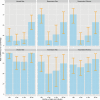Vector competence of Anopheles stephensi for O'nyong-nyong virus: a risk for global virus spread
- PMID: 37069603
- PMCID: PMC10111657
- DOI: 10.1186/s13071-023-05725-0
Vector competence of Anopheles stephensi for O'nyong-nyong virus: a risk for global virus spread
Abstract
Background: O'nyong-nyong virus (ONNV) is a mosquito-borne alphavirus causing sporadic outbreaks of febrile illness with rash and polyarthralgia. Up to now, ONNV has been restricted to Africa and only two competent vectors have been found, Anopheles gambiae and An. funestus, which are also known malaria vectors. With globalization and invasive mosquito species migrating to ONNV endemic areas, there is a possible risk of introduction of the virus to other countries and continents. Anopheles stephensi, is closely related to An. gambiae and one of the invasive mosquito species of Asian origin that is now present in the Horn of Africa and spreading further east. We hypothesize that An. stephensi, a known primary urban malaria vector, may also serve as a new possible vector for ONNV.
Methods: One-week-old female adult An. stephensi were exposed to ONNV-infected blood, and the vector competence for ONNV, i.e. infection rates (IRs), dissemination rates (DRs), transmission rates (TRs), dissemination efficiency (DEs) and transmission efficiency (TEs), were evaluated. Infection (IRs), dissemination efficiency (DEs) and transmission efficiency (TEs) were determined. Detection of ONNV RNA was analysed by RT-qPCR in the thorax and abdomen, head, wings, legs and saliva of the infected mosquitoes at four different time points, day 7, 14, 21 and 28 after blood meal. Infectious virus in saliva was assessed by infection of Vero B4 cells.
Results: The mean mortality across all sampling times was 27.3% (95 confidence interval [CI] 14.7-44.2%). The mean rate of infection across all sampling periods was 89.5% (95% CI 70.6-95.9). The mean dissemination rate across sampling intervals was 43.4% (95% CI 24.3-64.2%). The mean TR and TE across all mosquito sampling time intervals were 65.3 (95% CI 28.6-93.5) and 74.6 (95% CI 52.1-89.4). The IR was 100%, 79.3%, 78.6% and 100% respectively at 7, 14, 21 and 28 dpi. The DR was the highest at 7 dpi with 76.0%, followed by 28 dpi at 57.1%, 21 dpi at 27.3% and 14 dpi at the lowest DR of 13.04%. DE was 76%, 13.8%, 25%, 57.1% and TR was 79%, 50%, 57.1% and 75% at 7, 14, 21 and 28 dpi respectively. The TE was the highest at 28 dpi, with a proportion of 85.7%. For 7, 14 and 21 dpi the transmission efficiency was 72.0%, 65.5% and 75.0% respectively.
Conclusion: Anopheles stephensi is a competent vector for ONNV and being an invasive species spreading to different parts of the world will likely spread the virus to other regions.
Keywords: Alphavirus; Anopheles stephensi; Arthritis; O’nyong-nyong virus; Vector competence.
© 2023. The Author(s).
Conflict of interest statement
The authors declare that they have no competing interests.
Figures
Similar articles
-
Pathogenicity and virulence of O'nyong-nyong virus: A less studied Togaviridae with pandemic potential.Virulence. 2024 Dec;15(1):2355201. doi: 10.1080/21505594.2024.2355201. Epub 2024 May 26. Virulence. 2024. PMID: 38797948 Free PMC article. Review.
-
O'nyong-nyong fever: a neglected mosquito-borne viral disease.Pathog Glob Health. 2017 Sep;111(6):271-275. doi: 10.1080/20477724.2017.1355431. Epub 2017 Aug 22. Pathog Glob Health. 2017. PMID: 28829253 Free PMC article. Review.
-
Determinants of Chikungunya and O'nyong-Nyong Virus Specificity for Infection of Aedes and Anopheles Mosquito Vectors.Viruses. 2023 Feb 21;15(3):589. doi: 10.3390/v15030589. Viruses. 2023. PMID: 36992298 Free PMC article. Review.
-
Knockdown resistance allele L1014F introduced by CRISPR/Cas9 is not associated with altered vector competence of Anopheles gambiae for o'nyong nyong virus.PLoS One. 2023 Aug 10;18(8):e0288994. doi: 10.1371/journal.pone.0288994. eCollection 2023. PLoS One. 2023. PMID: 37561739 Free PMC article.
-
Development and evaluation of an external quality control and internal quality control containing real-time RT-PCR assay for the detection of o'nyong-nyong virus.Biologicals. 2023 Nov;84:101717. doi: 10.1016/j.biologicals.2023.101717. Epub 2023 Oct 4. Biologicals. 2023. PMID: 37801802
Cited by
-
Rift Valley Fever in Rwanda Is Urging for Enhancing Global Health Security Through Multisectoral One Health Strategy.Microorganisms. 2025 Jan 5;13(1):91. doi: 10.3390/microorganisms13010091. Microorganisms. 2025. PMID: 39858859 Free PMC article. Review.
-
Invasive Aedes albopictus is a competent vector for O'nyong Nyong virus.One Health. 2025 May 4;20:101062. doi: 10.1016/j.onehlt.2025.101062. eCollection 2025 Jun. One Health. 2025. PMID: 40630106 Free PMC article.
-
Mosquito populations originating from nonendemic areas have the potential to transmit recently emerging Japanese encephalitis virus genotype IV.Emerg Microbes Infect. 2025 Dec;14(1):2438661. doi: 10.1080/22221751.2024.2438661. Epub 2025 Jan 2. Emerg Microbes Infect. 2025. PMID: 39655411 Free PMC article.
-
Pathogenicity and virulence of O'nyong-nyong virus: A less studied Togaviridae with pandemic potential.Virulence. 2024 Dec;15(1):2355201. doi: 10.1080/21505594.2024.2355201. Epub 2024 May 26. Virulence. 2024. PMID: 38797948 Free PMC article. Review.
-
Wolbachia-Based Approaches to Controlling Mosquito-Borne Viral Threats: Innovations, AI Integration, and Future Directions in the Context of Climate Change.Viruses. 2024 Nov 30;16(12):1868. doi: 10.3390/v16121868. Viruses. 2024. PMID: 39772178 Free PMC article. Review.
References
MeSH terms
Grants and funding
LinkOut - more resources
Full Text Sources
Medical



